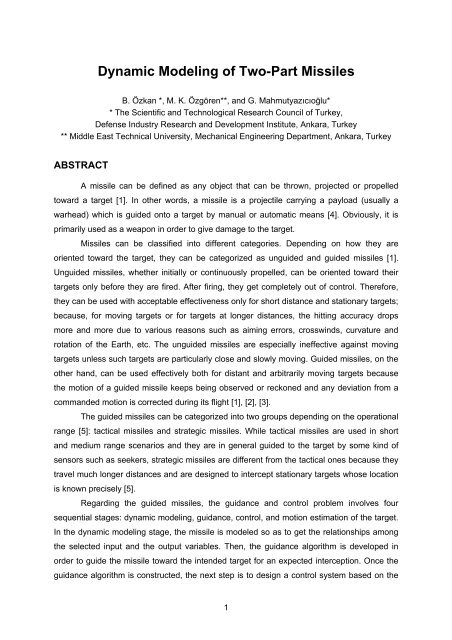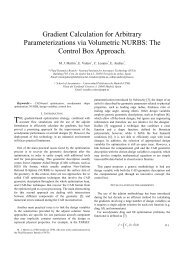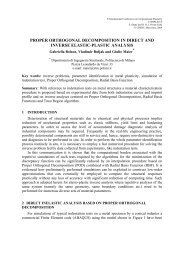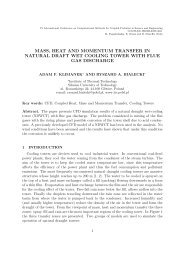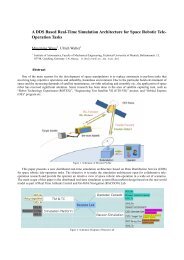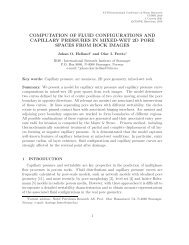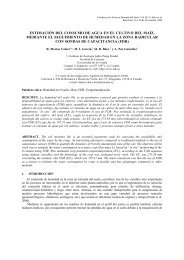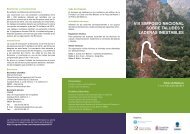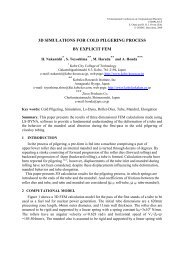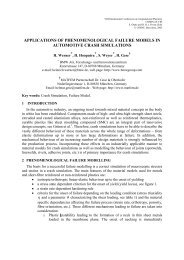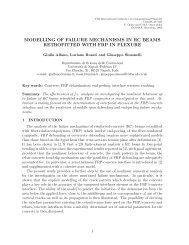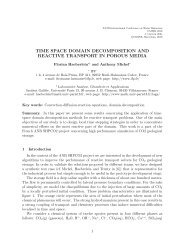Dynamic Modeling of Two-Part Missiles - Congress.cimne.com
Dynamic Modeling of Two-Part Missiles - Congress.cimne.com
Dynamic Modeling of Two-Part Missiles - Congress.cimne.com
You also want an ePaper? Increase the reach of your titles
YUMPU automatically turns print PDFs into web optimized ePapers that Google loves.
<strong>Dynamic</strong> <strong>Modeling</strong> <strong>of</strong> <strong>Two</strong>-<strong>Part</strong> <strong>Missiles</strong><br />
B. Özkan *, M. K. Özgören**, and G. Mahmutyazıcıoğlu*<br />
* The Scientific and Technological Research Council <strong>of</strong> Turkey,<br />
Defense Industry Research and Development Institute, Ankara, Turkey<br />
** Middle East Technical University, Mechanical Engineering Department, Ankara, Turkey<br />
ABSTRACT<br />
A missile can be defined as any object that can be thrown, projected or propelled<br />
toward a target [1]. In other words, a missile is a projectile carrying a payload (usually a<br />
warhead) which is guided onto a target by manual or automatic means [4]. Obviously, it is<br />
primarily used as a weapon in order to give damage to the target.<br />
<strong>Missiles</strong> can be classified into different categories. Depending on how they are<br />
oriented toward the target, they can be categorized as unguided and guided missiles [1].<br />
Unguided missiles, whether initially or continuously propelled, can be oriented toward their<br />
targets only before they are fired. After firing, they get <strong>com</strong>pletely out <strong>of</strong> control. Therefore,<br />
they can be used with acceptable effectiveness only for short distance and stationary targets;<br />
because, for moving targets or for targets at longer distances, the hitting accuracy drops<br />
more and more due to various reasons such as aiming errors, crosswinds, curvature and<br />
rotation <strong>of</strong> the Earth, etc. The unguided missiles are especially ineffective against moving<br />
targets unless such targets are particularly close and slowly moving. Guided missiles, on the<br />
other hand, can be used effectively both for distant and arbitrarily moving targets because<br />
the motion <strong>of</strong> a guided missile keeps being observed or reckoned and any deviation from a<br />
<strong>com</strong>manded motion is corrected during its flight [1], [2], [3].<br />
The guided missiles can be categorized into two groups depending on the operational<br />
range [5]: tactical missiles and strategic missiles. While tactical missiles are used in short<br />
and medium range scenarios and they are in general guided to the target by some kind <strong>of</strong><br />
sensors such as seekers, strategic missiles are different from the tactical ones because they<br />
travel much longer distances and are designed to intercept stationary targets whose location<br />
is known precisely [5].<br />
Regarding the guided missiles, the guidance and control problem involves four<br />
sequential stages: dynamic modeling, guidance, control, and motion estimation <strong>of</strong> the target.<br />
In the dynamic modeling stage, the missile is modeled so as to get the relationships among<br />
the selected input and the output variables. Then, the guidance algorithm is developed in<br />
order to guide the missile toward the intended target for an expected interception. Once the<br />
guidance algorithm is constructed, the next step is to design a control system based on the<br />
1
dynamic model <strong>of</strong> the missile so that it obeys the <strong>com</strong>mand signals generated by the<br />
guidance unit. The last stage is the estimation <strong>of</strong> the kinematic parameters <strong>of</strong> the target. For<br />
this task, it is conventional to use a state estimator algorithm such as Kalman filter or fading<br />
memory filter.<br />
As mentioned above, it is a primary requirement to obtain the relationships among the<br />
forces/moments acting on the missile and the kinematic state, i.e., position and velocity, <strong>of</strong><br />
the missile in order to design a control algorithm. The external forces and moments acting on<br />
a missile are those generated by the aerodynamic effects including control surfaces, the<br />
propulsion including control thrusters, and the gravity [6], [7]. As the results <strong>of</strong> these effects,<br />
the <strong>com</strong>ponents <strong>of</strong> the position vector <strong>of</strong> the missile along the downrange, crossrange and<br />
altitude directions change as well as the yaw, pitch and roll attitudes.<br />
It turns out that it is easier to model the inertial forces and moments than the<br />
aerodynamic force and moment <strong>com</strong>ponents. The aerodynamic force and moment terms are<br />
dependent both on the present and past values <strong>of</strong> the kinematic parameters <strong>of</strong> the missile. In<br />
order to model the aerodynamics <strong>of</strong> the symmetric missiles, one <strong>of</strong> the widely used methods<br />
is the Maple-Synge analysis [8]. With this method, the aerodynamic force and moment<br />
coefficients are related to the kinematic flight parameters by means <strong>of</strong> certain functions. For<br />
the sake <strong>of</strong> designing an autopilot, or the controller <strong>of</strong> missile control system, these<br />
coefficients are in general expressed as linear functions <strong>of</strong> angle <strong>of</strong> attack, side-slip angle, or<br />
skid angle, effective fin deflections, and body angular velocity <strong>com</strong>ponents [9], [10], [11],<br />
[12], [13]. Also, some analytical methods have been developed in order to predict the<br />
nonlinear aerodynamic forces and moments acting on a missile undergoing steady and<br />
unsteady maneuvers [14]. Some researchers have turned to neural networks as a means <strong>of</strong><br />
explicitly accounting for uncertain aerodynamic effects [15]. In modeling the aerodynamic<br />
forces and moments, the effect <strong>of</strong> aerodynamic drag on the missile is usually ignored<br />
because it causes only a slow change in the speed. As a result <strong>of</strong> this, the missile speed is<br />
treated to be almost constant throughout the after-boost phase [16].<br />
In the sense <strong>of</strong> the existence <strong>of</strong> the thrust effect, the motion <strong>of</strong> the missile can be<br />
primarily divided into two successive phases: boost phase and after-boost phase. As its<br />
name implies, the boost phase <strong>com</strong>prises the flight <strong>of</strong> the missile from the firing instant to the<br />
end <strong>of</strong> the thrust. Because the thrust supplied by the solid propellant in the rocket motor<br />
causes the missile to move ahead, the dynamics <strong>of</strong> the missiles in the boost phase can be<br />
modeled considering the nonzero effect <strong>of</strong> the thrust force and thus the changing mass [1],<br />
[10]. In the after-boost phase, the inertial parameters <strong>of</strong> the missiles, i.e., its mass and<br />
moment <strong>of</strong> inertia <strong>com</strong>ponents, remain unchanged.<br />
Although almost all <strong>of</strong> the guided missiles are single-body structures, there are also<br />
rarely seen two-body structures. An example is the so-called “Advanced Precision Kill<br />
2
Weapon System (APKWS)”. In this structure, the guidance section is mounted onto the<br />
motor section using a deroll bearing which permits the motor to roll freely while the guidance<br />
section is roll stabilized. The roll bearing causes unusual dynamic properties for this missile<br />
design because the airframe has two separate sections rolling at different rates. This fact<br />
creates additional dynamic coupling between the pitch and yaw channels <strong>of</strong> the missile [17].<br />
Like APKWS, the missile model dealt with in this study is also a two-body structure whose<br />
parts are connected to each other by means <strong>of</strong> a roller bearing [18].<br />
In this study, the dynamic modeling <strong>of</strong> a missile with two relatively rotating parts which<br />
are connected to each other by means <strong>of</strong> a roller bearing is dealt with. Completing the full<br />
kinematic analysis <strong>of</strong> the considered missile model, its governing differential equations <strong>of</strong><br />
motion are derived along with the aerodynamic force and moment terms. Finally, the<br />
necessary transfer functions to be used in the control system design stage are determined<br />
based on the derived equations <strong>of</strong> motion.<br />
Keywords: <strong>Two</strong>-part missile, homing missile, dynamic modeling, aerodynamic modeling,<br />
and transfer function<br />
REFERENCES<br />
[1]. Özgören, M. K., Seminar Notes on <strong>Dynamic</strong>s and Control <strong>of</strong> Guided <strong>Missiles</strong>, Middle<br />
East Technical University Continuing Education Center, February 21, 1991<br />
[2]. Chen, R. H., Speyer, J. L., and Lianos, D., “Homing Missile Guidance and Estimation<br />
under Agile Target Acceleration”, Journal <strong>of</strong> Guidance, Control, and <strong>Dynamic</strong>s, Vol. 30, No:<br />
6, pp. 1577-1589, November-December 2007<br />
[3]. Lin, C. F., Modern Navigation, Guidance and Control Processing, Prentice Hall<br />
Publication, Englewood Cliffs, New Jersey, 1991<br />
[4]. Frarr, D. j., “Control <strong>of</strong> Missile Airframes”, British Aerospace <strong>Dynamic</strong>s Group Report,<br />
1979<br />
[5]. Zarchan, P., Tactical and Strategic Missile Guidance, Vol. 157, Progress in<br />
Aeronautics and Astronautics, AIAA, Washington DC, 1994<br />
[6]. Berglund, E., “Guidance and Control Technology”, RTO SCI Lecture Series on<br />
Technologies for Future Precision Strike Missile Systems, Atlanta, USA, pp. 1-10, March<br />
2000<br />
[7]. Faruqi, F. A. and Vu, T. L., “Mathematical Models for a Missile Autopilot Design”, A<br />
Technical Report by DSTO Systems Sciences Laboratory, Edinburgh, Australia, 2002<br />
[8]. Tanrıkulu, Ö., “Non-Linear Flight <strong>Dynamic</strong>s <strong>of</strong> Unguided <strong>Missiles</strong>”, Ph.D. Thesis,<br />
Middle East Technical University, Türkiye, 1999<br />
3
[9]. Mahmutyazıcıoğlu, G., “<strong>Dynamic</strong>s and Control Simulation <strong>of</strong> an Inertially Guided<br />
Missile”, M.Sc. Thesis, Middle East Technical University, Türkiye, 1994<br />
[10]. Acar, Ş.U., “Trajectory Tracking by Means <strong>of</strong> Homing Guidance Methods”, M.Sc.<br />
Thesis, Middle East Technical University, Türkiye, 1996<br />
[11]. Tiryaki, K., “Polynomial Guidance Laws and <strong>Dynamic</strong> Flight Simulation Studies”,<br />
M.Sc. Thesis, Middle East Technical University, Türkiye, 2002<br />
[12]. Şahin, K. D., “A Pursuit Evasion Game between an Aircraft and a Missile”, M.Sc.<br />
Thesis, Middle East Technical University, Türkiye, 2002<br />
[13]. Vural, A. Ö., “Fuzzy Logic Guidance System Design for Guided <strong>Missiles</strong>”, M.Sc.<br />
Thesis, Middle East Technical University, Türkiye, 2003<br />
[14]. Mendanhall, M. R., Perkins, S. C., and Lesieutre, D. J., “Prediction <strong>of</strong> the Nonlinear<br />
Aerodynamic Characteristics <strong>of</strong> Maneuvering <strong>Missiles</strong>”, Journal <strong>of</strong> Spacecraft, Vol. 24, pp.<br />
394-402, September-October 1987<br />
[15]. McFarland, M. B. and Calise, A. J., “Neural Adaptive Nonlinear Autopilot Design for<br />
an Agile Anti-Air <strong>Missiles</strong>”, Proceedings <strong>of</strong> the AIAA Guidance, Navigation and Control<br />
Conference, San Diego, California, July 1996<br />
[16]. Babu, K. R., Sarma, I. G., and Swamy, K. N., “<strong>Two</strong> Robust Homing Missile Guidance<br />
Laws Based on Sliding Mode Control Theory”, IEEE Proceedings, pp. 540-547, 1994<br />
[17]. Mickle, M. C. and Zhu, J. J., “Skid to Turn Control <strong>of</strong> the APKWS Missile using<br />
Trajectory Linearization Technique”, Proceedings <strong>of</strong> the American Control Conference,<br />
Arlington, VA, pp. 3346-3351, June 25-27, 2001<br />
[18]. Özkan, B., <strong>Dynamic</strong> <strong>Modeling</strong>, Guidance, and Control <strong>of</strong> Homing <strong>Missiles</strong>, PhD<br />
Thesis, Mechanical Engineering Department, Middle East Technical University, Turkey, 2005<br />
4


